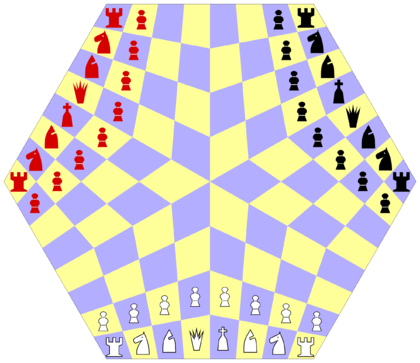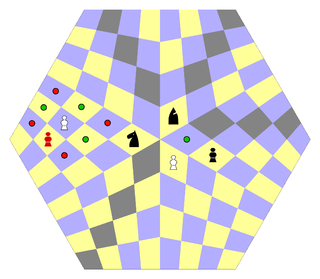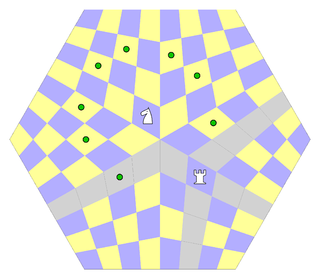
- Chess World Cup
- FIDE Grand Prix
- Olympiad
- World Championship
- List of strong tournaments
- List of world championships

- Checkmate patterns
- Chess openings
- Chess strategy
- Chess tactics
- Chess theory
- Endgames
- Pawn structure
- Problems/Compositions












 Three-Man Chess gameboard and starting position
Three-Man Chess gameboard and starting positionThree-Man Chess is a chess variant for three players invented by George R. Dekle, Sr. in 1984. The game is played on a hexagonal board comprising 96 quadrilateral cells. Each player controls a standard army of chess pieces.
Three-Man Chess was included in World Game Review No. 10 edited by Michael Keller.
The illustration shows the starting setup; each player's queen is placed to the left of his king. White moves first and play proceeds clockwise around the board. Pieces move the same as they do in chess, with some special features described below. Standard conventions apply including castling, a pawn's initial two-step option, en passant, and promotion. The first player to checkmate an opponent wins the game.
 The bishop moves along diagonals in the diagram colored dark gray and changes square colors if crossing the center. White's king pawn can advance to the cell with green dot, or capture Black's knight, pawn, or bishop. (The bishop cannot take the pawn, however, since it is not on a diagonal path for doing so.) White's pawn in Red territory is an "arrow pawn" able to move to green dots (one of which promotes) or capture on red dots. It cannot capture Red's pawn, which is also blocking it from moving to that cell. (Should the red pawn move forward, White can take it. For example, if the red pawn moves forward with a double-step, White can take it diagonally backwards e.p.)
The bishop moves along diagonals in the diagram colored dark gray and changes square colors if crossing the center. White's king pawn can advance to the cell with green dot, or capture Black's knight, pawn, or bishop. (The bishop cannot take the pawn, however, since it is not on a diagonal path for doing so.) White's pawn in Red territory is an "arrow pawn" able to move to green dots (one of which promotes) or capture on red dots. It cannot capture Red's pawn, which is also blocking it from moving to that cell. (Should the red pawn move forward, White can take it. For example, if the red pawn moves forward with a double-step, White can take it diagonally backwards e.p.)
 The rook moves along the rank and file in the diagram colored light gray. The knight can move to any cell with a green dot.
The rook moves along the rank and file in the diagram colored light gray. The knight can move to any cell with a green dot.A player who is stalemated loses his turns to move, unless/until an opponent plays a move that releases the stalemate condition. While stalemated, his king is still subject to checkmate, and his other pieces are still subject to capture.